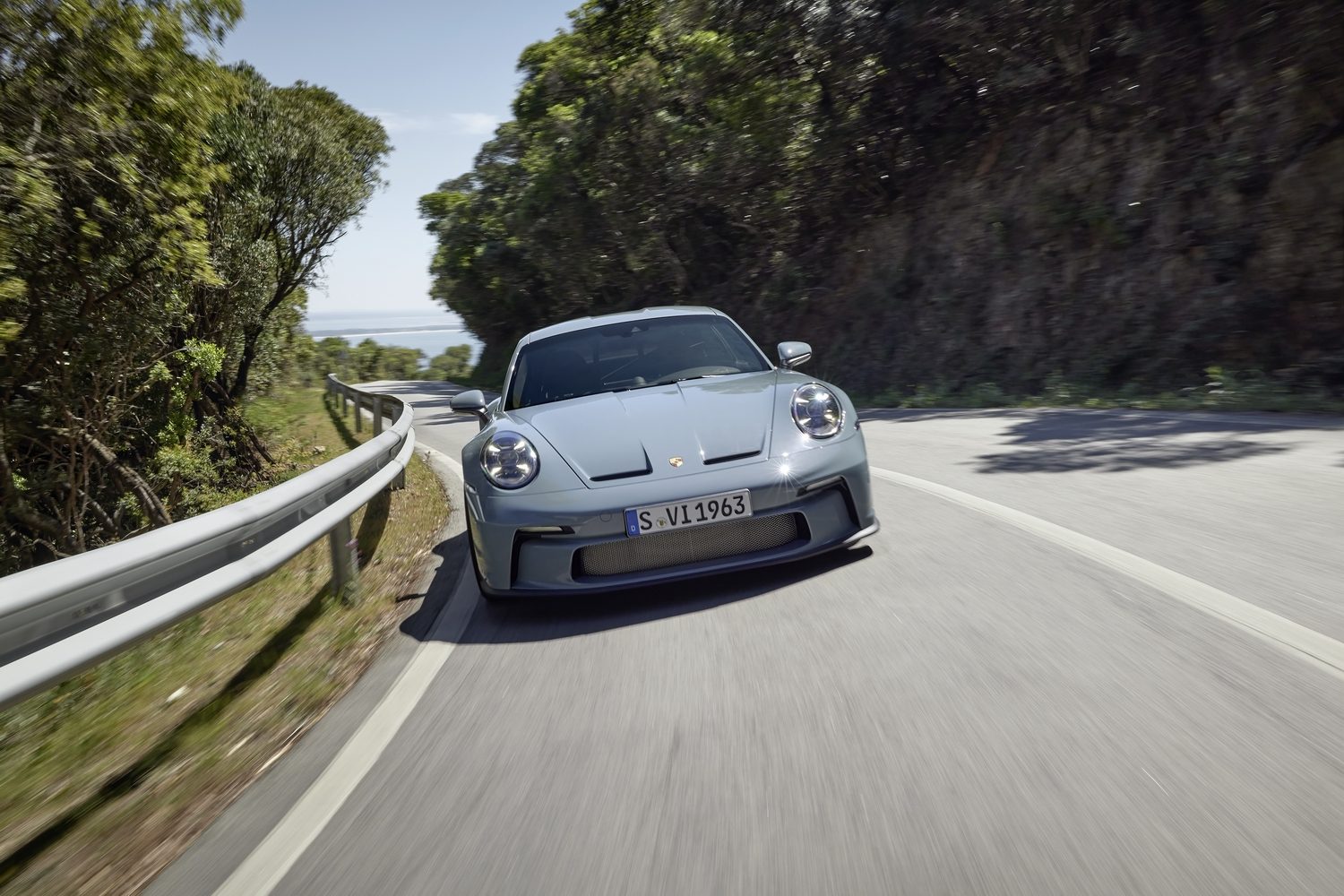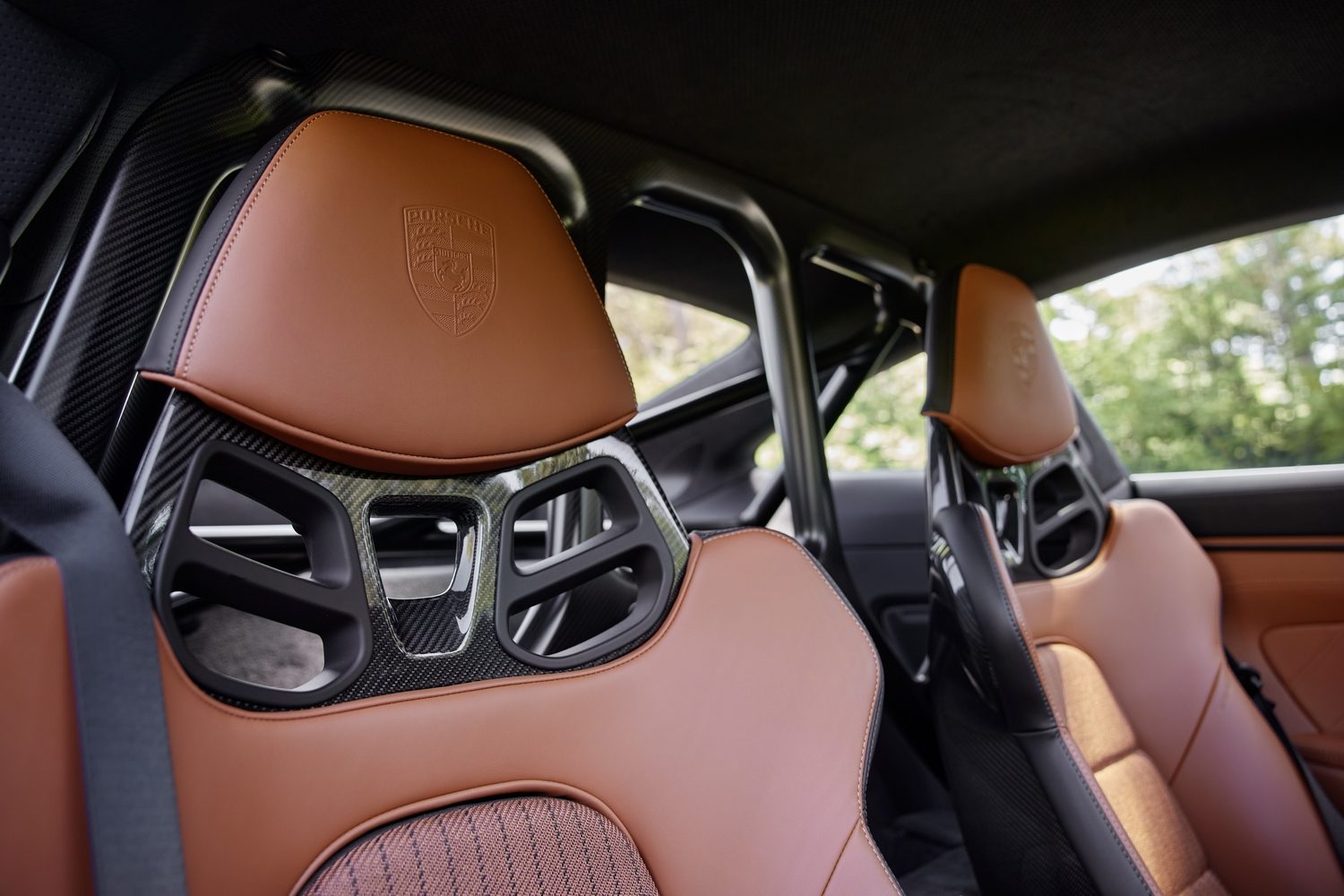A new, updated Porsche 911, the 992.2, is already out, but the German manufacturer is not letting the old version go out with a whimper. Instead, we’ve got the rally-spec Dakar, the awesome Sport Classic and this: the S/T. It’s a reincarnation of a badge from the 911’s history, and it’s intended as a classically styled 911 for purists to enjoy.
A heritage-inspired interior, lightweight body and a manual gearbox will all please fans of the 911, as will the naturally aspirated, 4.0-litre flat-six that drives the rear wheels. Porsche is well aware that this version of the now-familiar 992-generation 911 won’t be for everyone, but will it do more than just bring in dedicated customers? To find out, we seized the opportunity to drive one for the first time, on UK roads.

What does the Porsche 911 S/T look like?
Essentially, the 911 S/T is based on the GT3 Touring model, and it would be easy to confuse the two. The nose is much the same, defined by the bonnet ‘nostrils’, but the S/T is set apart by its details. The front wings and doors are sculpted like those on the aerodynamically optimised GT3 RS, and the roof is from the RS, too. Centre-lock alloy wheels add to the effect, and though you can’t see it, those body panels are largely made from carbon fibre, and the glass is thinner and lighter.

At the rear, there’s a retractable spoiler, while those who choose the optional Heritage Design Package get access to special paint jobs and graphics, as well as cool Porsche badging and silver mesh grilles. Basically, all the stuff fitted to our test car. Do that, and the overall look is a timeless one, albeit still striking. This is a car that attracts way more attention than a common-or-garden 911, even if the onlookers in question may not quite be able to put their finger on why.
A look inside the Porsche 911 S/T

Although the 911 S/T is a stripped-back version that weighs less than 1.4 tonnes, it isn’t so stripped back that there’s no sense of luxury. The cockpit is much the same as that of any other 911, with the same dashboard, the same touchscreen infotainment system and the same ‘hybrid’ instrument cluster that combines an analogue rev counter with customisable digital screens in the same binnacle. You even get climate control. And it’s just as well built as any other 911, with the same high-quality materials and the same solid construction.
There are a few differences, though, especially for cars fitted with the Heritage Design Package seen on our test vehicle. As standard, the S/T comes with bucket seats trimmed in black leather, with pinstripe cloth inserts and white contrast stitching, although electrically adjustable sports seats are available as an option. You get fabric door pulls, too, to save a bit of weight, although that saving has probably been undone by the special-edition graphics on the dash. More effective is that the rear seats have been removed in favour of a kind of parcel shelf.
But if you go for the Heritage Design Package, you add to that with two-tone leather and Cognac fabric seat centres, while there’s leather trim on the dashboard, steering column and the door opening loops, as well as an old-school Porsche crest on the head restraints, the steering wheel and the vehicle key. You even get Heritage Design floor mats.

And our test car came with a few other goodies, including a roll cage in carbon fibre-reinforced plastic and a Bose sound system. Naturally, the roll cage has an impact on the usefulness of the aforementioned parcel shelf, limiting the practicality and the view out of the back, but there’s something fitting about having it in the S/T’s cabin. And there’s always the ‘boot’, which lives under what would normally be the bonnet, and feels more spacious than its 132-litre capacity might suggest.
How fast is the Porsche 911 S/T?
Although the S/T is more about engagement and feel than outright pace, it still has plenty of power and comparatively little weight, which is a combination that usually equates to lots of performance. Especially when the figures in question are 525hp and 1,380kg. That means the S/T has around 400hp per tonne, which is a pretty impressive ratio for anything outside of motorsport, and it performs accordingly, roaring its way from 0-100km/h in 3.7 seconds and hitting a top speed of 300km/h.

But what really impresses is the way it delivers that power. Instead of turbocharging the engine to squeeze out more punch, as Porsche has done with the Carrera, Carrera T, Carrera S and Carrera GTS models, the German brand has stuck with the conventionally aspirated 4.0-litre flat-six engine from the GT3 RS. That’s because turbocharged engines don’t deliver their power as predictably or as smoothly as naturally aspirated engines, and the S/T, remember, is all about purity.
Hence the inclusion of a six-speed manual gearbox and the decision to send all the power to the rear wheels, as is traditional in a 911. But while the search for Porsche purity undoubtedly influenced those decisions, it wasn’t the only consideration. Rear-wheel-drive 911s are lighter than the all-wheel-drive equivalents, and manual gearboxes are generally lighter than automatics, too. Especially this one, which is a particularly lightweight transmission.

It’s very sharp, and it’s very low-geared, which means you feel the need to change gear more often thereby adding to the fun, if not the performance. It also means the S/T will happily pull in fifth gear at 50km/h. But if you want to wring the engine out and enjoy its full vocal range - and we recommend that you do - you can hold off on the gear changes until you approach the 9,000rpm redline. As you do, the rear-mounted engine bellows behind your head, and the sound blasts through the empty rear cabin and the thin lightweight glass. It’s a visceral experience, and it gains a bit of an edge when you set the sports exhaust to work.
However, there are some quirks to the S/T that won’t suit everyone. Chief among these is the fitment of a single-mass flywheel, which might not mean much to you and me, but it has a noticeable effect. Essentially, it means the S/T’s engine is less refined than it would be with a dual-mass flywheel, and the clutch is much more highly strung, but it reduces drag in the engine and cuts down on weight.
But it makes the clutch quite delicate, and you have to drive the S/T accordingly. It’s best looked after by starting off with no accelerator input at all, and simply releasing the clutch pedal gently. It feels as though you’re going to stall when you first try it, but the anti-stall system prevents that and once the clutch is engaged, you can drive normally. It’s the same procedure as used in the old Porsche Carrera GT, although that car was famous for eating clutches for breakfast, lunch and dinner.

Driving the Porsche 911 S/T
It’s a car’s quirks that give it character, and the 911 S/T very much feels like a living thing. The lightweight construction, the connection with the engine and the snappy gearbox are matched by the tactility of every control, the feedback through the seat and the mechanical noises from which you’re intentionally unprotected.
The steering wheel wriggles as the car traverses bumps, forcing you to correct slightly, and the ride is quite firm, thanks to suspension taken from the 911 GT3 Touring. And don’t think you can get away from it by selecting a different mode, because there are no driving modes in the S/T, apart from a button to make the damping even firmer. In truth, you can’t really tell the difference between the two settings when you’re out and about, but if you pay close attention, you can feel a little more bite to the bumps when the sportier setting is engaged.

In fairness, the ride is not back-breaking, as it is in a GT3 RS, and the bucket seats are more comfortable than you might expect, but the idea is that you can feel everything the car is doing, in the hope that will make you feel like an organic part of the machine.
And what a machine it is. The GT3 DNA is immediately apparent in the precision of the steering and the sharpness with which it turns into corners. Grip is monstrous, and body control is excellent, allowing you to hurl it into bends at speeds other sports cars - and even some other 911s - might find abusive. And because you can feel everything, you know exactly how hard each component is working, from the ultra-sticky tyres to the stupendous brakes, and from the clutch to the pistons. On a good back road, which is the car’s natural habitat, it’s a formidable thing.
That is, of course, as long as you treat it nicely. The gearbox is snappy for a reason - namely that you need to shift quickly to match the revs, because that flywheel allows the engine to spin up and down in a heartbeat - and while there’s a selectable throttle-blip system to help you with downshifts, you’re on your own on the way up through the gears. Getting it right is satisfying, but it isn’t always easy.

Around town and day-to-day, then, the S/T is far from ideal. But if everyday usability is what you want from your 911, the dealer will gladly show you a Carrera 4S instead. If you want to blast along your favourite country road, the S/T is perfect.
How much does the Porsche 911 S/T cost in Ireland?
At €436,793, the S/T is horrendously expensive. It’s more than twice the price of a basic Carrera, and that’s a €200,000 car once you’ve got the one you want. So, if you’re after value for money, look elsewhere. However, for those with pockets deep enough, the S/T comes with a very appealing range of standard features, aside from the performance-related stuff.

Bucket seats, silver exterior trim and alloys with exclusive covers are all standard in a sporty but elegant specification, while classic ‘Heritage Design’ two-tone leather interior seen in these pictures is a no-cost option. And despite the car being lightweight, climate control, navigation and the ‘hybrid’ instrument display comprising a classic analogue rev counter and digital ancillary screens are all included in the price.
We would recommend a couple of options, though. The Heritage Design Package is really a must for this car, and so too is the optional front-axle lift kit, allowing you to raise the nose over speed bumps. The reversing camera system is a good idea, too.
The reasons you’d buy a Porsche 911 S/T

Yes, the S/T is outrageously expensive, and yes, it’s a bit highly strung. But if you want warts-and-all driving, and you want it to look, sound and feel utterly breathtaking, this is the car for you. It’s no everyday 911 - plenty of other models in the Porsche sports car range will do that job - but if you like driving for driving’s sake, and you want to feel like an organic part of a spectacular machine, the S/T is the ultimate sports car.
Ask us anything about the Porsche 911 S/T
If you would like to know more about the 911 S/T, or any other Porsche model, or indeed any other car on sale in Ireland, why not head over to our Ask Us Anything page? There, you can post whatever motoring question you need answering, and our hive mind of automotive experts will get you the information you need. Best of all, it’s completely free.


























